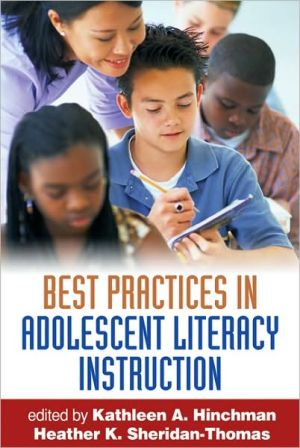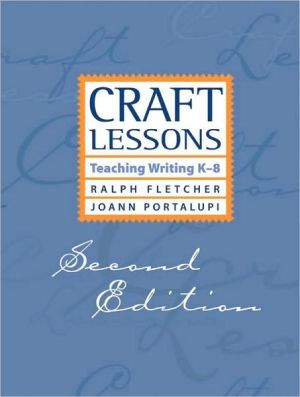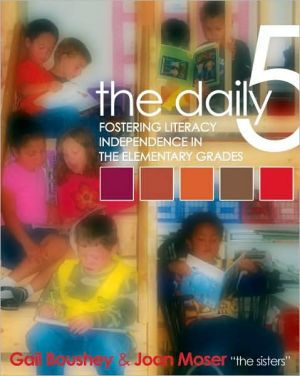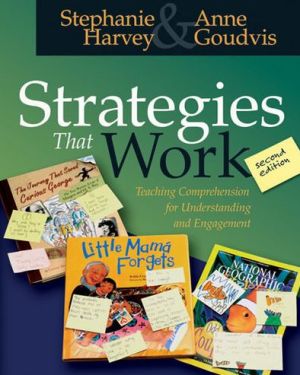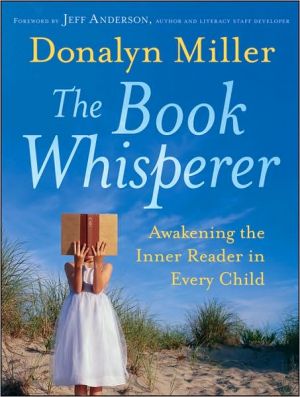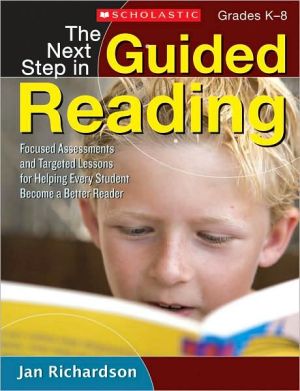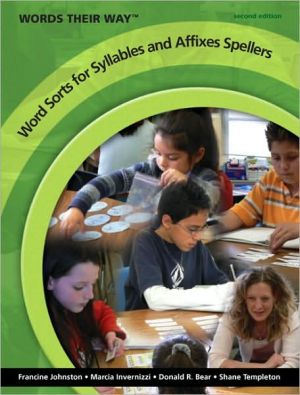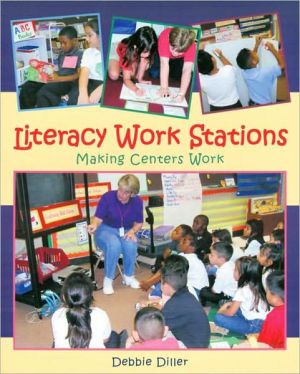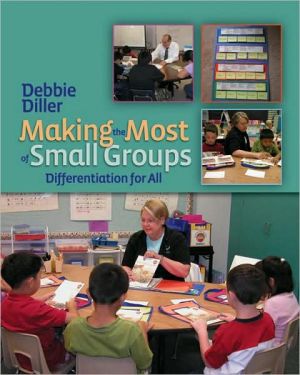Best Practices in Adolescent Literacy Instruction
Covering everything from day-to-day learning activities to schoolwide goals, this engaging book reviews key topics in literacy instruction for grades 5-12 and provides research-based recommendations for practice. Leading scholars present culturally responsive strategies for motivating adolescents; using multiple texts and digital media; integrating literacy instruction with science, social studies, and math; and teaching English language learners and struggling readers. Vivid case studies,...
Search in google:
Covering everything from day-to-day learning activities to schoolwide goals, this engaging book reviews key topics in literacy instruction for grades 5-12 and provides research-based recommendations for practice. Leading scholars present culturally responsive strategies for motivating adolescents; using multiple texts and digital media; integrating literacy instruction with science, social studies, and math; and teaching English language learners and struggling readers. Vivid case studies, thoughtful discussion questions and activities in each chapter, and detailed ideas for program and lesson planning make this an indispensable classroom resource and professional development tool. Children's Literature This edited collection epitomizes the best of "theory into practice" writing about multiple aspects of adolescent literacy. Chapters are authored by experts in their respective areas and offer a variety of definitions, perspectives, and approaches to this broad term—meaning that there is probably something useful here for everyone who interacts with adolescents in an educational capacity. Teachers are acknowledged as the creative and guiding forces they can and should be when helping adolescents maximize their literacy competencies. Relevant research is compellingly translated into actual classroom scenarios, often accompanied by sample assignments and student responses. The level of coverage ranges from general understanding of motivation in reading to working with individual students. Digital literacies, teaching across texts and modalities, aspects of critical thinking, program development, and assessment are some of the many topics addressed by individual chapters. Specific content areas (e.g., math, history, social studies) and populations (e.g., English language learners, older youth, special needs students) are highlighted. The format shows considerable editorial oversight and exemplifies aspects of "considerate" texts. Each chapter is preceded by the main points to be addressed and followed by a conclusion and a "Discussion and Activities" section, which encourages active reflection on what was covered. This is NOT just a book for those addressing the language arts and reading, rather a useful handbook for anyone teaching adolescents. Reviewer: Paula McMillen, Ph.D.
Pt. I Perspectives toward Adolescent Literacy Instruction1 Discussing Texts with Adolescents in Culturally Responsive Ways Alfred W. Tatum Tatum, Alfred W. 32 Meaningful Content for Middle School Students for Whom English Is an Additional Language Eliane Rubinstein-Avila Rubinstein-Avila, Eliane Janelle Johnson Johnson, Janelle 203 Rethinking Literacy Learning and Teaching: Intersections of Adolescents' In-School and Out-of-School Literacy Practices Shelley Hong Xu Xu, Shelley Hong 394 iLife: Understanding and Connecting to the Digital Literacies of Adolescents Dana J. Wilber Wilber, Dana J. 575 The Role of Motivation in Engaged Reading of Adolescents David G. O'Brien O'Brien, David G. Deborah R. Dillon Dillon, Deborah R. 78Pt. II Developing Reading and Writing Strategies for Multiple Contexts6 Actively Engaging Middle School Students with Words Karen Bromley Bromley, Karen 997 Strategy Matters: Comprehension Instruction for Older Youth Rachel Brown Brown, Rachel 1148 Reading and Writing across Multiple Texts Cynthia Hynd Shanahan Shanahan, Cynthia Hynd 1329 Multimodality and Literacy Learning: Using Multiple Texts to Enhance Content-Area Learning Fenice B. Boyd Boyd, Fenice B. Mary K. Thompson Thompson, Mary K. 15110 Assisting Struggling Readers with Textbook Comprehension Heather K. Sheridan-Thomas Sheridan-Thomas, Heather K. 16411 The Reality of Challenging Texts in High School Science and Social Studies: How Teachers Can Mediate Comprehension Elizabeth Birr Moje Moje, Elizabeth Birr Jennifer Speyer Speyer, Jennifer 18512 Humanities Instruction for Adolescent Literacy Learners Kelly Chandler-Olcott Chandler-Olcott, Kelly21213 Fostering Acquisition of Official Mathematics Language Codruta Temple Temple, Codruta Kathleen A. Hinchman Hinchman, Kathleen A. 229Pt. III Adolescent Literacy Program Issues14 Intervening When Older Youth Struggle with Reading Gay Ivey Ivey, Gay 24715 Instructional Moves That Support Adolescent Learners Who Have Histories of Failure Douglas Fisher Fisher, Douglas Nancy Frey Frey, Nancy 26116 Traveling Together over Difficult Ground: Negotiating Success with a Profoundly Inexperienced Reader in an Introduction to Chemistry Class Cindy Litman Litman, Cindy Cynthia Greenleaf Greenleaf, Cynthia 27517 Literacy Assessment for Adolescents: What's Fair about It? Mark W. Conley Conley, Mark W. 29718 Program Development David W. Moore Moore, David W. 31319 Multiple Dimensions of Adolescent Literacy Teacher Education Patricia L. Anders Anders, Patricia L. 339Index 361
\ Children's Literature\ - Paula McMillen\ This edited collection epitomizes the best of "theory into practice" writing about multiple aspects of adolescent literacy. Chapters are authored by experts in their respective areas and offer a variety of definitions, perspectives, and approaches to this broad term—meaning that there is probably something useful here for everyone who interacts with adolescents in an educational capacity. Teachers are acknowledged as the creative and guiding forces they can and should be when helping adolescents maximize their literacy competencies. Relevant research is compellingly translated into actual classroom scenarios, often accompanied by sample assignments and student responses. The level of coverage ranges from general understanding of motivation in reading to working with individual students. Digital literacies, teaching across texts and modalities, aspects of critical thinking, program development, and assessment are some of the many topics addressed by individual chapters. Specific content areas (e.g., math, history, social studies) and populations (e.g., English language learners, older youth, special needs students) are highlighted. The format shows considerable editorial oversight and exemplifies aspects of "considerate" texts. Each chapter is preceded by the main points to be addressed and followed by a conclusion and a "Discussion and Activities" section, which encourages active reflection on what was covered. This is NOT just a book for those addressing the language arts and reading, rather a useful handbook for anyone teaching adolescents. Reviewer: Paula McMillen, Ph.D.\ \ \ \ \ From the Publisher"'Exuberance' is a word often used to describe adolescence, and one that could also be applied to this text. The contributors recognize adolescents' complexities, their sophisticated use of technology, their deep feelings. Whether discussing knowledge learned about literacy in discipline-specific classrooms, out-of-school literacies, digital literacies, or responses to classic literature, every chapter has real students at its core. It is clear that the contributors have listened to adolescents and truly respect them as caring, capable thinkers who have much to offer."--Pamela A. Michel, PhD, Professor and Chair, Department of Curriculum and Instruction, Oswego State University\ "As schools begin to respond to a rekindling of focus on adolescent literacy, the need for quality guidance and resources has never been greater. For those of us who have interacted with middle and high school students over our entire careers, this book is a much-anticipated 'must read.' Best Practices in Adolescent Literacy Instruction taps many of the most credible voices in the field to provide in-depth and thoughtful discussions of current approaches and initiatives. Educators want to hear what these authors have to say."--Doug Buehl, MS, adolescent literacy specialist, Madison, Wisconsin\ "Best Practices in Adolescent Literacy Instruction will be an enduring work, providing direction for all of us concerned with the literacy lives of adolescents. In one volume, we have the major figures of the adolescent literacy community sharing their understanding of effective practices, the insights that guide those practices, and important program development issues."--Donald J. Leu, PhD, John and Maria Neag Endowed Chair in Literacy and Technology, University of Connecticut\ "This cutting-edge volume combines the most recent theories and innovations in adolescent literacy with rich, down-to-earth, classroom-based perspectives. Attention to disciplinary contexts and domains, as well as the recognition that students need teacher scaffolding and guidance in order to move toward independent learning, are mainstays of the book. I particularly like the presence of student voices and the fact that each chapter includes a summary discussion and extension activities. I could see using this book as a main text in an adolescent literacy course or as a resource for professional development."--Thomas W. Bean, PhD, Department of Curriculum and Instruction, University of Nevada, Las Vegas\ "Hinchman and Sheridan-Thomas hit on many current issues and topics about which secondary teachers and administrators are clamoring for more information. This book is a great resource for collegial dialogue and professional development. I look forward to sharing it with middle and high school administrators, department chairs, other learning coordinators, and literacy coaches."--Ella E. Briand, CAS, Humanities Field Coordinator, Syracuse City School District, New York\ \ \
